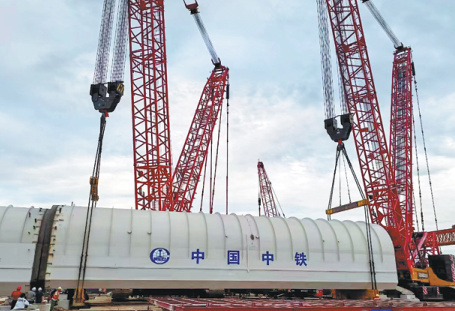Pioneering maglev on fast track to success
Updated: 2023-12-08

Construction workers of China Railway Sixth Bureau Group use heavy machines to install a pipeline for the vactrain test line in Datong. [Photo by Du Xiu for China Daily]
After more than two years of construction, the main structures of China's first trial line for a vacuum tube maglev train with independent intellectual property rights were completed in the Shanxi city of Datong late last month, marking a significant breakthrough in this cutting-edge transportation system.
The 2-kilometer line, with 1.55 km built by the Datong high-speed flying train project unit of China Railway Sixth Bureau Group, is the first phase of a laboratory jointly developed by Shanxi and China Aerospace Science and Industry Corp. The inauguration of the lab and groundbreaking of the test line took place in May 2021.
The purpose of the lab is to provide a key test platform for the low-vacuum tube magnetic levitation train technology.
The high-tech train, which is also known as vactrain or high-speed flying train in the industry, is designed to run inside a virtually air-free tube to reduce resistance.
Executives of CASIC said the company began its research into vactrain technology in 2017 and has achieved breakthroughs in key technologies in the years since.
The test line at the lab in Yanggao county in Datong will be a full-size line with a total length of 60 km and will be built in three phases.
The 2-km line of the first phase will be used to collect basic data for operations, so it is crucial for the developers to push their research and development work to a new stage, according to Yang Xufeng, chief engineer of the Datong high-speed flying train project unit of China Railway Sixth Bureau.
He added that after about two years' research in the first phase, the line will eventually be extended to 60 km to test the vactrain's technologies for commercial use.
"While China's researchers have made breakthroughs in technologies relating to the vactrain, a reliable infrastructure system allowing the trains to run and test its performances is of equal importance," Yang said. "When we were commissioned to build the test line project, we were fully aware that this is the most challenging mission in the history of our company. But the following two years have proved that we have the competence to tackle all the challenges."
Installing the vacuum tube, which is done by putting together pipelines each with a diameter of 6 meters and a length of 21 meters, for instance, requires great accuracy, according to Yang.
"The high accuracy is a must for an air-free vacuum tube system that allows the safe operation of maglev trains," Yang said. "As a whole, the size differences of the pipelines should be controlled at less than 2 millimeters."
He added that there are also strict requirements for the accuracy of the flatness of rails, in welding and others. "We are glad to say that all our works have passed the appraisals by authoritative experts."
Industry insiders said vactrains can reach a speed of more than 1,000 km per hour, much faster than the conventional bullet train that travels at under 400 km/h.
They added that as the system uses the latest technologies such as superconducting magnetic levitation and vacuum tubing, it is expected to cultivate a powerful and wide-covering industry chain in Shanxi province, pushing forward its advanced manufacturing and high-tech industries to a new level.
Leng Xue contributed to this story.



